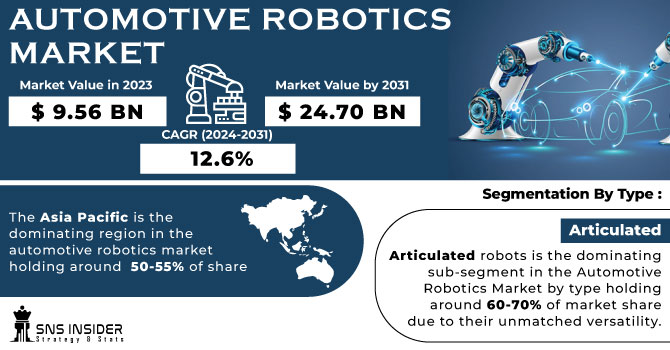
The Automotive Robotics Market is expected to witness significant growth due to the increasing demand for electric vehicles, growing focus on automation, and rising adoption of robots by small and medium-sized enterprises.
The automotive robotics market, valued at USD 9.76 billion in 2023, is anticipated to reach USD 24.59 billion by 2031, registering a compound annual growth rate (CAGR) of 12.24% from 2024 to 2031.
Market Scope:
Automotive robots play a crucial role in various stages of car production, from welding and painting to assembly and material handling. The surging demand for electric vehicles has significantly fueled the use of robots to meet the growing consumer demand. Articulated robots dominate the market, while welding remains the most common robotic application. Companies are increasingly embracing automation to reduce costs, save time, and enhance productivity while minimizing errors. Collaborative efforts between robots and human workers in production plants further improve efficiency and reduce workload. Realtime Robotics’ Optimization-as-a-Service solution, successfully implemented by Volkswagen, exemplifies this trend. With advancements in vehicle technology and the rising popularity of electric vehicles, automotive robotics is expected to witness robust growth, driving demand for various robotic operations in the automobile production process. Recognizing this potential, robotic manufacturers are actively launching new models to cater to the high demand.
Available Exclusive Sample Copy Of This Report @ https://www.snsinsider.com/sample-request/1027
Market Analysis:
The rise of cost-effective and user-friendly robotic solutions is driving significant adoption among small and medium-sized enterprises (SMEs) in the manufacturing space, traditionally dominated by large enterprises. This increased accessibility is exemplified by a Korean semiconductor equipment supplier that saw a 50% productivity boost after installing 77 domestic collaborative robots. This trend is expected to further propel the widespread adoption of robotics in the automotive industry.
Beyond cost savings, robots offer several advantages over human labor. Their consistent and repetitive nature minimizes part-to-part variability and damage, while vision systems allow them to adapt to variations in incoming materials. This translates to fewer mistakes, higher customer satisfaction, and lower warranty costs.
Market Segment
By Type
- Articulated
- Cartesian
- Cylindrical
- SCARA
- Others
By Application
- Welding
- Painting
- Material Handling
- Assembly/Disassembly
- Others
Segment Analysis:
Welding Robots Hold the Highest Share:
Welding robots leads the automotive industry, holding the dominant share of the market. These robots, both semiautomatic and automatic, offer unmatched precision, efficiency, and speed, leading to increased factory safety and significant cost savings. They play a crucial role in producing advanced, lightweight vehicles, consistently meeting strict industry standards. As the demand for electric and self-driving cars rises, requiring even more precise assembly, companies are increasingly relying on advanced robotic welding systems. For instance, Ficep UK’s new automatic and robotic processing solution addresses the need for high-quality welding while tackling labor shortages and boosting productivity.

Click Here for More Information About This Study @ https://www.snsinsider.com/reports/automotive-robotics-market-1027
Geopolitical and Economic Challenges: Short-Term Headwinds for Automotive Robotics
The automotive robotics market faces short-term challenges due to the ongoing Russia-Ukraine war and the global economic slowdown. The war has disrupted supply chains, leading to delays and price increases for robot components. Additionally, the economic uncertainty has caused cautious investment decisions in the automotive industry, potentially impacting robot demand. However, the long-term outlook remains positive, driven by the continued focus on automation and the rising popularity of electric vehicles.
Asia-Pacific is Expected to Lead the Automotive Robotics Market:
Asia-Pacific is witnessing a surge in the adoption of robotics technology, driven by its potential for automation, efficiency gains, and reduced human error. This trend cuts across various sectors, including automotive, healthcare, defense, and aerospace.
The region’s dominance in the automotive industry and its lower manufacturing costs are fueling significant expected growth in the automotive robotics market. Additionally, the rapid expansion of small and medium-sized enterprises and government support for automation initiatives further propel the market forward.
Asia-Pacific is also the fastest-developing region globally, with countries like China, India, Taiwan, and South Korea leading the way. Major robotics vendors like ABB and KUKA are establishing their presence in the region, further solidifying its position as a preferred hub for automotive manufacturing.
China and India are key players in the region’s development. The opening of factories by various industries, including automotive, electronics, and aviation, is driving demand for automotive robotics, making Asia-Pacific a leading and rapidly growing market.
From the Automotive Robotics Market Study, you will learn about:
Market size and growth: The current size of the global automotive robotics market and its projected growth rate over the next few years.
Key drivers and trends: The factors that are driving the growth of the market, such as the rising demand for electric vehicles, increased focus on automation, and growing adoption of robots by small and medium-sized enterprises.
Market segmentation: The different types of robots used in the automotive industry, such as welding robots, painting robots, and assembly robots.
Regional trends: The growth of the automotive robotics market in different regions of the world, with a particular focus on Asia-Pacific as a leading and rapidly growing market.
Challenges and opportunities: The potential challenges facing the market, such as the impact of the Russia-Ukraine war and the global economic slowdown, as well as the opportunities for growth driven by the increasing demand for electric vehicles and continued focus on automation.
Prominent Key Players of Market
- FANUC Corporation (Japan)
- Kawasaki Heavy Industries
- Yaskawa Electric Corporation (Japan)
- KUKA AG (Germany)
- ABB (Switzerland)
- Comau
- DENSO WAVE INCORPORATED
- NACHI-FUJIKOSHI CORP.
- Rockwell Automation Inc.
- Seiko Epson Corporation
- and other key players.
Recent Developments:
KUKA AG plans to introduce two systems for robotics education and showcase metalworking technologies with partners, as well as additive manufacturing offerings, at FABTECH 2023, North America’s largest metal forming, fabrication, welding, and finishing event.
ABB signed a contract with Volvo Cars to supply 1,300 industrial robots for building its next generation of electric vehicles. The robots will be used for various tasks, including spot welding, riveting, dispensing flow drilling, and more.
Enquiry or Share Your Questions If Any Before Purchasing This Report @ https://www.snsinsider.com/enquiry/1027
Our Related Report



